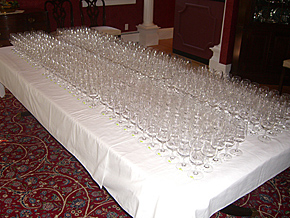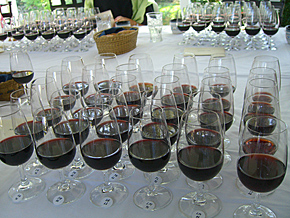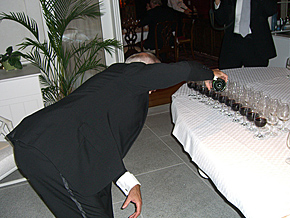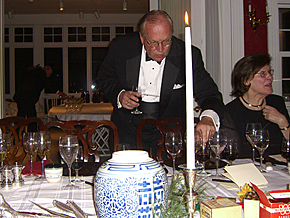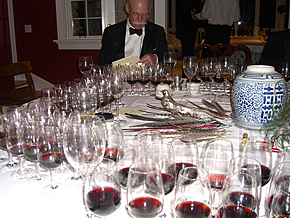North America Dispatch #37: Bordeaux Out to Here
New London, New Hampshire
Today I’m at the home of my friends Jack and Thelma, who really know how to throw a party. For the story of how I met Jack and Thelma, listen to the podcast in yesterday’s report.
Here are some shots of their place:
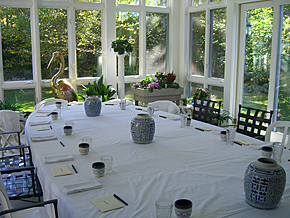
The garden room, used for the afternoon tasting.
Click the photo below to read the day’s game plan (wine lovers: no drooling on the keyboard!):
A few early arrivals had stopped by the night before for an informal wine-geek potluck, bringing along this stupendous selection of bottles. As impressive as today’s wines are, I’m not sure they’ll eclipse this eclectic array in terms of sheer lusciousness:
Here are the 54 bottles we’ll open this weekend (leaving aside, of course, the champagne, the white wines, the burgundies, and the port):
The stemware and the Big Pour:
The view from my seat:
My friend Jim (see last two reports) demonstrates stage one of the spitting process by slobbering into a small bowl …
... which is later transferred to the “spit bucket” ...
... which, surprisingly, has no euphemism.
This tasting’s set-up was unique and very clever. It was both a vertical tasting (where multiple vintages of a given wine are compared) and a horizontal tasting (where multiple wines of a given vintage are compared). Each flight consists of two Bordeaux poured in 1966, 1986, and 1996 vintages, or six glasses total. This means tons of comparison fun and the chance to learn about each winemaker over time … and about each time over winemakers!
The unique approach of this tasting produced a firm conclusion at stark odds with conventional wisdom. Only by drinking virtually all of Bordeaux (at least all the good stuff!) for 1966, 1986, and 1996 were we able to notice a huge problem missed by all the experts—who’d been blindered by drinking either horizontally OR vertically. Here’s how it unfolded.
On the first few flights, the 1986s were pronounced “corked.”
Corked wines are bottles in which a bad cork has imparted a moldy, dank aroma. Corked bottles are actually fairly common, but while the aroma is quite specific, it’s amazing how frequently even experts miss it or disagree about it. I’ve seen highly experienced tasters strain to describe the je ne sais quoi of a wine, only to see one shrug and mutter, “It’s corked,” with the rest quickly nodding in sheepish accord. For one thing, there are varying degrees of corkedness, so it’s not always that obvious. And in some wines, the off aroma can hide more easily behind other aromas.
The first few 1986s were declared either “corked” or “slightly corked” by most. But the problem didn’t stop as the tasting unfolded; ‘86s in subsequent flights were also nebbishy and musty. The group grew confused. Wines don’t cork in patterns—it’s usually a random problem unrelated to vintage or maker. (And the exceptions, where a large run of bottles turned out badly, are well known.)
But virtually every 1986 had the same off quality, to varying extents. The entire vintage wasn’t corked … it was simply cursed.
This doesn’t mean the 1986s were all bad. If we were drinking only 1986—a horizontal tasting of various makers—we’d have enjoyed the better ones, and made note of the differences between the wines rather than their unfortunate similarities. And if we were drinking only specific wines vertically, we’d have likewise noted whatever merit there was in the 1986s. In at least a few cases, that merit was fairly substantial—just not compared with those same wines in 1996 and 1966!
Only via this weirdo approach—tasting all the 1986s in contrast with other vintages—were we able to ascertain that the 1986 vintage was actually quite lousy, and seems unlikely to improve with age. If you’ll consult the esteemed wine references, though, you’ll see that the unanimous conclusion is that it was a pretty decent vintage. Myth busted!
The evening tasting was black tie and took place in the formal dining room. The harvest theme involved lots of birds and guns and bullets. Fortunately, arguments rarely turn violent at these things.
A few quick thoughts about the wines:
Chateau Palmer, a third-growth (i.e., officially “third-rate”) maker, produced my all-time favorite wine in 1966. As always, the ‘66 Palmer gripped me in a transportive and intensely multilayered symphony. I’ve never been to a wine tasting in which 1966 Palmer was poured where it didn’t thoroughly steal the show—and this is no exception.
The really top Bordeaux were pretty darned good even in 1986 (the mark of a great maker is the ability to play the hand that’s dealt and produce class in problematic years) but still showed lingering touches of that offness. What on earth happened in 1986? Meteor strike?
The 1996 vintage is excellent, with great potential. It might be a bit underrated. Chateau Margaux 1996 shows huge promise. It will grow up to be screamingly great.
Jim had a brief moment of mortification late in the evening tasting. Between flights, two tasters are asked to give their assessments. When it was Jim’s turn, he panicked, froze up, rifled around for his notes, and started stammering about wines drunk hours ago.
It could have happened to any of us. And the crowd reaction was loving (howls of laughing WITH Jim rather than at him). Wine can be a status token for those who seek such things. Snobs have an investment in self-esteem to protect. But these guys aren’t like that. They just really love wine. And they like anyone who shares their indomitable quest to appreciate ever more deeply and acutely. Even weirdo jazz musician intruders like me.
I hadn’t trekked to the Bardstown Kentucky Bourbon Festival to guzzle lots of bourbon. I can do that at home! I was just following an innate human drive to share great things with kindred spirits. And as I downed what amounted to $1,200 worth of Bordeaux today, I didn’t feel any more rarefied or upscale than I had sipping bourbon in Kentucky. It was, in fact, the exact same spirit: learning and sharing with my fellow holdouts—folks who proactively seek quality rather than consume in mindless lockstep. We huddle together for warmth in a society where compromise is king.
Food, by guest chefs, was very correct and enjoyable (not real soulful, but, alas, Thelma can’t throw the party AND cook for everyone!). But one interesting wrinkle: One meal concluded with a dessert of vanilla custard, poached sekel pear, and duck foie tuile. The latter was essentially a cookie fried in duck foie gras fat, which lent a pervasive nutty richness that by no means seemed undessert-like. What a neat idea! Here it is:
Somehow amid the frenzy I managed to record an audio interview with Thelma, discussing her views on food, cooking, the ever-increasing level of deliciousness, and the legacy of her friend Julia Child. (Note: This was recorded before the release of the book The United States of Arugula, which covers some of the same ground.)
It’s in two parts:
+ + +
This tasting is an incredibly enjoyable and educational annual phenomenon that thoroughly spoils one for anything wine related for weeks and weeks. But the event also raises questions about big tastings, aesthetics, and the purpose of wine. Tasting such a quantity of great wine in such unnatural compaction makes it inevitable that fallacies will arise. Always eager to grow and to calibrate my palate, I pay careful attention to the opinions of the more knowledgeable tasters … but I sometimes notice blind spots amid the erudition.
The following is an email I sent Thelma after last year’s tasting, comparing the pitfalls and absurdities of wine tastings to those of beauty pageants and music competitions:
“Judging a right brain thing like wine in a left brain environment like a formal tasting creates unavoidable problems. Most of all, we tend to over-analyze and under-feel.
“There were some wines that told beautiful stories in slightly crooked, tangential ways … but were despised. There were some that sang beautiful songs quite softly … but were dismissed. There were a bunch that were beautiful in a less obvious, more nebulous way that failed to draw any praise at all. There were wines which had great emotional impact but offered less intellectually, and they were underrated. When wine tasting becomes a beauty pageant (as it must in the unquestionably clinical atmosphere of a massive tasting), there’s a tendency to quickly dismiss the girl with the crooked tooth. And I felt that a lot of the picks were for the most perfect glossy gal. I’m always bored by that sort of thing. I’m not so contrarian as to prefer fault for fault’s sake, but I couldn’t escape the feeling that some of the favorites were the wines with the fewest detectable flaws, rather than those with the most appreciable beauty.
“In piano competitions, judges are quick to winnow out contestants who miss even a single trivial note—they’re WATCHING for errors, in a way that they would not if they were simply enjoying a performance in a natural environment. “Spot-the-flaw” is the natural method by which the human mind distinguishes between large numbers of similar items. But this tendency must be, to some degree, resisted, because it occludes appreciation for the deeper qualities which, in the end, are what we seek and value in wine, music, etc.”
« Previous Post: Body by Jim, Plus Astounding Ecuadorian Railroad Pizza«
»Next Post: Wine Geek Boat Trip »







